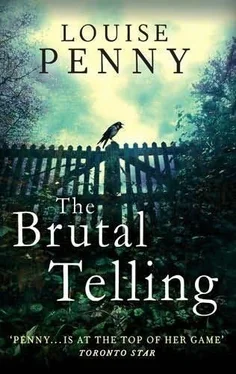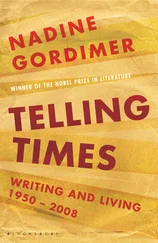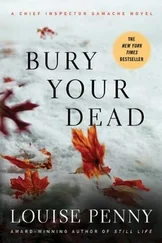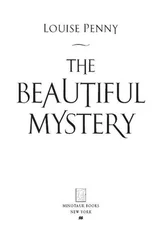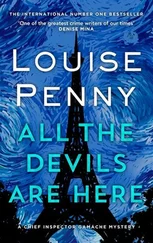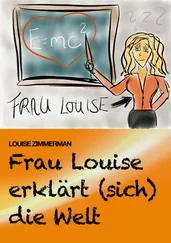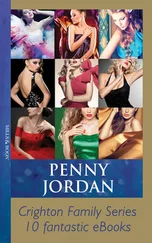“I’ve found your ‘woo.’ ”
THIRTY


“There it is.” Thérèse Brunel pointed.
They’d driven into downtown Montreal and now the Superintendent was pointing at a building. Gamache slowed the car and immediately provoked honking. In Quebec it was almost a capital crime to slow down. He didn’t speed up, ignored the honking, and tried to see what she was pointing at. It was an art gallery. Heffel’s. And outside was a bronze sculpture. But the car had drifted past before he got a good look. He spent the next twenty minutes trying to find a parking spot.
“Can’t you just double-park?” asked Superintendent Brunel.
“If we want to be slaughtered, yes.”
She harrumphed, but didn’t disagree. Finally they parked and walked back along Sherbrooke Street until they were in front of Heffel’s Art Gallery, staring at a bronze sculpture Gamache had seen before but never stopped to look at.
His cell phone vibrated. “ Pardon ,” he said to the Superintendent, and answered it.
“It’s Clara. I’m wondering when you might be ready.”
“In just a few minutes. Are you all right?” She’d sounded shaky, upset.
“I’m just fine. Where can I meet you?”
“I’m on Sherbrooke, just outside Heffel’s Gallery.”
“I know it. I can be there in a few minutes. Is that okay?” She sounded keen, even anxious, to leave.
“Perfect. I’ll be here.”
He put the phone away and went back to the sculpture. Silently he walked around it while Thérèse Brunel watched, a look of some amusement on her face.
What he saw was an almost life-sized bronze of a frumpy middle-aged woman standing beside a horse, a dog at her side and a monkey on the horse’s back. When he arrived back at Superintendent Brunel he stopped.
“This is ‘woo’?”
“No, this is Emily Carr. It’s by Joe Fafard and is called Emily and Friends .”
Gamache smiled then and shook his head. Of course it was. Now he could see it. The woman, matronly, squat, ugly, had been one of Canada’s most remarkable artists. Gifted and visionary, she’d painted mostly in the early 1900s and was now long dead. But her art only grew in significance and influence.
He looked more closely at the bronze woman. She was younger here than the images he’d seen of her in grainy old black-and-white photos. They almost always showed a masculine woman, alone. In a forest. And not smiling, not happy.
This woman was happy. Perhaps it was the conceit of the sculptor.
“It’s wonderful, isn’t it?” Superintendent Brunel said. “Normally Emily Carr looks gruesome. I think it’s brilliant to show her happy, as she apparently only was around her animals. It was people she hated.”
“You said you’d found ‘woo.’ Where?”
He was disappointed and far from convinced Superintendent Brunel was right. How could a long dead painter from across the continent have anything to do with the case?
Thérèse Brunel walked up to the sculpture and placed one manicured hand on the monkey.
“This is Woo. Emily Carr’s constant companion.”
“Woo’s a monkey?”
“She adored all animals, but Woo above all.”
Gamache crossed his arms over his chest and stared. “It’s an interesting theory, but the ‘woo’ in the Hermit’s cabin could mean anything. What makes you think it’s Emily Carr’s monkey?”
“Because of this.”
She opened her handbag and handed him a glossy brochure. It was for a retrospective of the works of Emily Carr, at the Vancouver Art Gallery. Gamache looked at the photographs of Carr’s unmistakable paintings of the West Coast wilderness almost a century ago.
Her work was extraordinary. Rich greens and browns swirled together so that the forest seemed both frenzied and tranquil. It was a forest long gone. Logged, clear-cut, ruined. But still alive, thanks to the brush and brilliance of Emily Carr.
But that wasn’t what had made her famous.
Gamache flipped through the brochure until he found them. Her signature series. Depicting what haunted any Canadian soul who saw them.
The totem poles.
Sitting on the shores of a remote Haida fishing village in northern British Columbia. She’d painted them where the Haida had put them.
And then a single perfect finger pointed to three small words.
Queen Charlotte Islands.
That’s where they were.
Charlotte.
Gamache felt a thrill. Could they really have found Woo?
“The Hermit’s sculptures were carved from red cedar,” said Thérèse Brunel. “So was the word Woo. Red cedar grows in a few places, but not here. Not Quebec. One of the places it grows is in British Columbia.”
“On the Queen Charlotte Islands,” whispered Gamache, mesmerized by the paintings of the totem poles. Straight, tall, magnificent. Not yet felled as heathen, not yet yanked down by missionaries and the government.
Emily Carr’s paintings were the only images of the totems as the Haida meant them to be. She never painted people, but she painted what they created. Long houses. And towering totem poles.
Gamache stared, losing himself in the wild beauty, and the approaching disaster.
Then he looked again at the inscription. Haida village. Queen Charlottes.
And he knew Thérèse was right. Woo pointed to Emily Carr, and Carr pointed to the Queen Charlotte Islands. This must be why there were so many references to Charlotte in the Hermit’s cabin. Charlotte’s Web , Charlotte Brontë. Charlotte Martinù, who’d given her husband the violin. The Amber Room had been made for a Charlotte. All leading him here. To the Queen Charlotte Islands.
“You can keep that.” Superintendent Brunel pointed to the brochure. “It has a lot of biographical information on Emily Carr. It might be helpful.”
“ Merci .” Gamache closed the catalog and stared at the sculpture of Carr, the woman who had captured Canada’s shame, not by painting the displaced, broken people, but by painting their glory.
Clara stared at the gray waters of the St. Lawrence as they drove over the Champlain Bridge.
“How was your lunch?” Gamache asked when they were on the autoroute heading to Three Pines.
“Well, it could have been better.”
Clara’s mood was swinging wildly from fury to guilt to regret. One moment she felt she should have told Denis Fortin more clearly what a piece of merde he was, the next she was dying to get home so she could call and apologize.
Clara was a fault-magnet. Criticisms, critiques, blame flew through the air and clung to her. She seemed to attract the negative, perhaps because she was so positive.
Well, she’d had enough. She sat up straighter in her seat. Fuck him. But, then again, maybe she should apologize and stand up for herself after the solo show.
What an idiot she’d been. Why in the world had she thought it was a good idea to piss off the gallery owner who was offering her fame and fortune? Recognition. Approval. Attention.
Damn, what had she done? And was it reversible? Surely she could have waited until the day after the opening, when the reviews were in the New York Times , the London Times . When his fury couldn’t ruin her, as it could now.
As it would now.
She’d heard his words. But more important, she’d seen it in Fortin’s face. He would ruin her. Though to ruin implied there was something built up to tear down. No, what he’d do was worse. He’d make sure the world never heard of Clara Morrow. Never saw her paintings.
She looked at the time on Gamache’s dashboard.
Читать дальше
